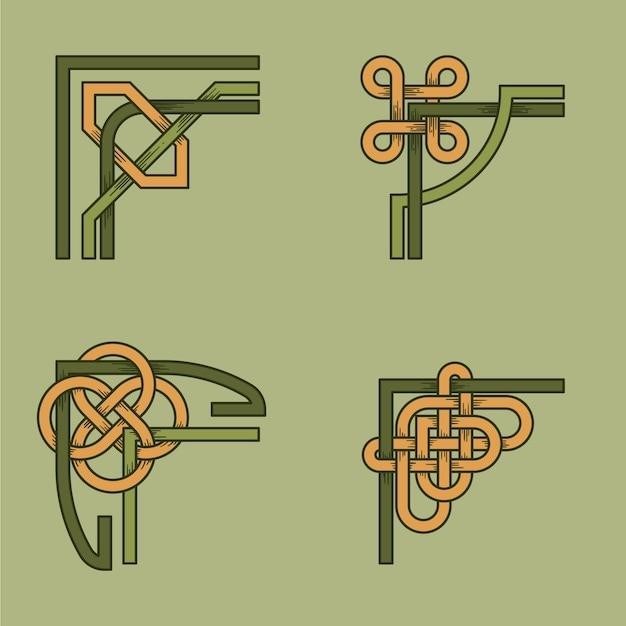Celtic Knotwork Tutorial⁚ A Step-by-Step Guide
This comprehensive guide will take you through the fascinating world of Celtic knotwork, from the basic building blocks to more complex designs. Learn the secrets of creating intricate patterns that have captivated artists for centuries.
Introduction
Celtic knotwork, a captivating style of ornamentation, has enchanted artists and observers for centuries. These intricate patterns, often found in ancient manuscripts, monuments, and jewelry, seem to defy logic, creating an illusion of endless, interwoven cords. This tutorial will unlock the secrets of Celtic knotwork, guiding you through the steps to create your own stunning designs.
Celtic knotwork is not simply a decorative element; it holds deep cultural and spiritual significance. In Celtic mythology, knots symbolize the interconnectedness of all things, the eternal cycle of life, and the enduring nature of the universe. The absence of beginnings and endings in these knots further reinforces the concept of eternity.

This tutorial will delve into the fundamentals of Celtic knotwork, starting with the basic unit of crossed cords and progressing to more complex designs. You’ll learn about the grid method for creating intricate patterns, explore the history and symbolism of Celtic knotwork, and gain inspiration to design your own unique creations.
The Basic Unit⁚ Crossed Cords
The foundation of all Celtic knotwork lies in a simple yet essential element⁚ the crossed cords. Imagine two strands of rope intersecting in a square. This seemingly basic unit is the building block for all the intricate patterns that characterize Celtic knotwork. The key to understanding crossed cords lies in recognizing their handedness. A right-handed cross is formed when one cord starts from the top left corner and runs diagonally down to the bottom right, crossing over the second cord. Conversely, a left-handed cross is formed when the cord starts from the top right and goes diagonally down to the bottom left, crossing over the other cord.
The beauty of Celtic knotwork arises from the strategic arrangement and repetition of these crossed cords. The patterns are created by carefully weaving lines of right-handed crosses with lines of left-handed crosses, creating a continuous, uninterrupted flow. Each line in a Celtic knot consists of a series of right-handed crosses alternating with left-handed crosses, creating a visually captivating pattern. This seemingly simple concept opens the door to a world of intricate and fascinating designs.
Understanding the concept of crossed cords is crucial for anyone wishing to delve into the world of Celtic knotwork. By mastering this fundamental element, you’ll be well on your way to creating your own unique and stunning patterns.
Joining Cords and Creating a Continuous Knot
Once you’ve mastered the concept of crossed cords, the next step is to learn how to connect them seamlessly to create a continuous knot. This involves understanding how to make the cords “flow” into each other, creating a visually compelling and uninterrupted pattern. The key lies in ensuring that each cord smoothly transitions into another, without any breaks or loose ends. Imagine a strand of rope weaving through itself, creating a complex and interwoven design.
To achieve this, you need to carefully plan the path of each cord. Each cord must pass over and under other cords in a consistent and predictable pattern. This might seem complex at first, but with practice, you’ll develop an intuitive sense for how to create these smooth transitions. One approach is to trace the path of each cord as it weaves through the design. Pay close attention to where it passes over and under other cords, ensuring that this pattern is maintained throughout the knot.
This process of joining cords and creating a continuous knot is the heart of Celtic knotwork. It’s where the simple building blocks of crossed cords transform into intricate and visually captivating designs. By mastering this technique, you’ll unlock the potential to create your own unique and beautiful Celtic knotwork;
Expanding the Knot⁚ Length and Complexity
The beauty of Celtic knotwork lies in its adaptability. While the basic crossed cord unit is the foundation, you can expand upon it to create knots of varying lengths and complexities. It’s like weaving a tapestry, where each additional thread adds depth and intricacy to the overall pattern. This ability to scale and elaborate allows for a wide range of creative possibilities, from simple and elegant designs to elaborate and intricate masterpieces.
To expand the knot’s length, you simply repeat the process of joining cords, extending the pattern across a greater area. This can be done by adding more crossed cords, creating a larger grid, or by extending the existing cords in a continuous loop. The choice is yours, allowing for endless variations in size and shape. The complexity of the knot, on the other hand, is achieved by introducing more twists and turns in the cord’s path. This can involve adding additional crossing points, creating more elaborate interweaving patterns, or even incorporating different types of knot units within a single design.
Experimenting with different approaches to expanding the knot is a crucial part of the learning process. It allows you to develop a feel for how each change affects the overall design, encouraging you to push the boundaries of your creativity. Remember, the key is to maintain the consistency and continuity of the knot, ensuring that each strand seamlessly weaves through the design, creating a harmonious and visually engaging pattern. This is where the art of Celtic knotwork truly shines.
Celtic Knotwork in Art and History
Celtic knotwork, a captivating art form deeply rooted in ancient Celtic culture, has a rich and fascinating history, spanning centuries and leaving its mark on various forms of artistic expression. These intricate designs, often found in illuminated manuscripts, stone carvings, and metalwork, hold a powerful presence in the art world. The origins of Celtic knotwork are shrouded in the mists of time, tracing back to the Iron Age, when the Celts inhabited a vast region across Europe. These intricate designs, often featuring interlaced patterns without beginning or end, symbolize the interconnectedness of life, the cyclical nature of time, and the enduring spirit of the Celtic people.

Some of the most renowned examples of Celtic knotwork can be found in the Book of Kells, an illuminated manuscript dating back to the 8th or 9th century. This masterpiece showcases the artistry and skill of Celtic monks, who meticulously crafted elaborate knot patterns that adorn the pages, illuminating the text with breathtaking beauty. The Lindisfarne Gospels, another illuminated manuscript, also showcases the intricate art of Celtic knotwork, captivating viewers with its intricate designs and vibrant colors.
Beyond manuscripts, Celtic knotwork found its way into various forms of art, including intricate carvings on stone monuments, intricate patterns on jewelry, and delicate designs on metalwork; These captivating patterns have inspired artists throughout the ages, influencing various artistic styles and continuing to captivate viewers with their timeless beauty and symbolic depth. Today, Celtic knotwork remains a vibrant art form, with contemporary artists reinterpreting these ancient designs and incorporating them into modern creations, keeping the tradition alive for generations to come;
Tools and Materials
Embarking on your Celtic knotwork journey requires a modest collection of tools and materials, readily available to enhance your creative process. A pencil, your trusty companion for sketching and outlining your designs, is a must-have. A sharp pencil will allow you to create precise lines, ensuring that your knotwork patterns flow seamlessly. A ruler, your guide for accuracy, will assist in creating straight lines and maintaining consistent proportions in your designs. Graph paper, an invaluable aid for creating intricate patterns, provides a structured grid that simplifies the process of drawing Celtic knots.
An eraser, your faithful companion for correcting mistakes, is essential for refining your designs and achieving a polished look. Pencils and pens, in a variety of colors, provide options for adding depth and dimension to your Celtic knotwork creations, allowing you to express your artistic vision. A compass, a tool for drawing perfect circles, comes in handy for creating circular patterns and adding a touch of elegance to your designs. A protractor, your guide for measuring angles, ensures accuracy when creating intricate curves and angles in your Celtic knotwork.
Optional tools, such as a French curve, a flexible template for drawing curves, and a set of stencils, pre-cut templates for Celtic knot patterns, can further enhance your creative process, offering a variety of options for creating intricate designs. These tools provide a foundation for crafting captivating Celtic knotwork, allowing you to translate your imagination into intricate and beautiful patterns.
Grid Method for Drawing Celtic Knots
The grid method is a powerful technique for drawing Celtic knots, providing a structured framework that simplifies the process and ensures accuracy. It involves using graph paper, with its evenly spaced squares, as your canvas. This method transforms the intricate patterns into a series of interconnected lines, making the process more manageable. The grid acts as a visual guide, helping you to maintain consistent proportions and spacing, leading to a more balanced and pleasing final design.
To begin, choose a grid size that suits your design. Larger squares allow for bolder, more expansive knots, while smaller squares create more intricate and detailed patterns. Next, visualize the knot you want to create and map out the basic shape using the grid lines. Start by marking the key intersections and points where the lines of the knot will change direction. Then, carefully connect these points with straight lines, following the grid lines as your guide. As you draw, focus on ensuring that the lines flow smoothly and that the knot interlaces correctly; This method allows you to build the knot step-by-step, making corrections as you go.
Once you have drawn the basic shape, you can refine the lines, adding curves and slight adjustments to create a more organic and visually appealing design. The grid method is particularly helpful for beginners, providing a sense of order and structure, making it easier to learn the intricacies of Celtic knotwork. It also allows you to experiment with different designs, confidently creating your own unique variations.
Designing Your Own Celtic Knot
Once you’ve grasped the fundamentals of Celtic knotwork, it’s time to unleash your creativity and design your own unique patterns. The beauty of Celtic knots lies in their adaptability, allowing for infinite variations and personal interpretations. Drawing inspiration from ancient manuscripts, stone carvings, or even nature itself, can ignite your imagination and provide a starting point for your creations.
Begin by experimenting with basic shapes. Start with simple squares, circles, or triangles, and explore how you can interlace lines within these shapes to create intricate knots. Don’t be afraid to experiment with different directions, thicknesses, and angles. You can also incorporate elements from other cultures, such as geometric patterns or floral motifs, to add a unique twist to your designs.
Remember, there are no strict rules when it comes to designing Celtic knots. Embrace your creativity and let your ideas flow freely. As you progress, you’ll find yourself creating more complex and elaborate patterns. You can use tools like a compass and ruler to ensure accuracy and symmetry in your designs. Experiment with different grid sizes and spacing to achieve varying levels of detail and complexity. The possibilities are endless, so let your imagination guide you as you create your own unique Celtic knot masterpieces.
Advanced Techniques and Resources
As you delve deeper into the world of Celtic knotwork, you’ll discover a wealth of advanced techniques and resources to enhance your skills and explore more intricate designs. One such technique involves incorporating multiple knot units into a single design, creating complex and visually captivating patterns. This can involve weaving together different types of knots, such as square knots, heart knots, and ring knots, to achieve a harmonious balance of complexity and elegance.
Another advanced technique involves the use of symmetry and repetition. By creating a basic knot unit and then repeating it across a grid or plane, you can generate intricate and symmetrical patterns with a sense of order and harmony. This can be achieved through the use of computer software or through meticulous hand-drawn designs. Exploring the concept of tessellation can also be a fruitful avenue for generating complex and visually interesting Celtic knotwork patterns.
For those seeking further inspiration and guidance, a plethora of resources are available online and in print. Numerous websites offer tutorials, step-by-step guides, and galleries of Celtic knotwork designs. Books and articles on the subject provide a deeper historical context and explore the cultural significance of Celtic knotwork. Connecting with other artists and enthusiasts through online forums and communities can also be a valuable source of inspiration and collaboration, fostering a shared passion for this ancient and enduring art form.



